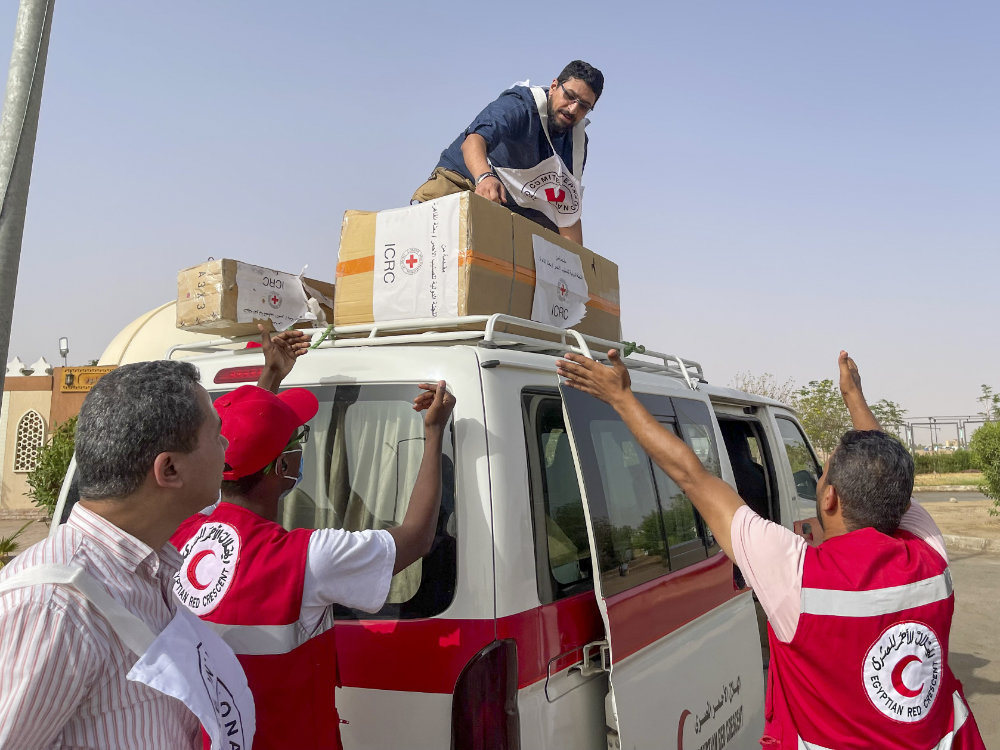Sexual violence is widespread and prevalent in many modern armed conflicts. Interviewing the people who have endured sexual violence is one of the most challenging tasks for any journalist.
In this post to mark the 30th campaign of the 16 Days of Action, Drew Ambrose – one of Al Jazeera English’s most experienced and awarded foreign correspondents – describes his experience and technique for reporting on these pervasive acts of brutality in conflict zones.
Content and trigger warning: This post involves details that may be upsetting to some readers.
When I was a young cadet journalist in the newsroom, one seasoned editor gave me this piece of advice at the start of my career: ‘When someone has witnessed or endured tragedy- guide that person to the top of the mountain of trauma, then bring them back down’.
Sixteen years later, I still find interviewing sexual violence survivors who escaped a conflict zone an incredibly difficult task, weighted with a sense of heavy responsibility to ‘get it right’. Sometimes you spend hours restructuring the questions beforehand – mindful that an interview handled badly could be an emotional trigger.
It is extremely unlikely to get earnest candid testimony when you open your line of questioning with ‘So tell me about the worst thing that ever happened to you?’ Interviewing a survivor requires building rapport and, more often than not, the safest approach I adopt is to ask questions in a chronological timeline. Getting someone to tell their story in a linear fashion is a simple way to make sure you get all the facts and details in a methodical way. Such an approach also helps in ensuring that you don’t make people recount traumatic events over and over in an insensitive fashion.
But a chronological approach to interviewing is almost impossible when you can’t gauge when the horror actually began for a rape survivor who has escaped war or genocide.
Interviewing Anna
This was the situation I was confronted with some years ago, when I was researching one of the biggest refugee crises in recent history.
I still remember looking out over the IDP camp from a hilltop. There was a seemingly endless sea of huts made of tarpaulin, sticks and old food aid sacks sprawled over an area bigger than many European cities. In some ways, hearing the sound of hammers and witnessing a mass of humanity rebuilding their lives after enduring indescribable atrocities made me ponder and appreciate the resilience of those affected.
As the days went on, however, that optimism would burst like a bubble as the first wave of dark stories from survivors of sexual violence emerged from the camps.
One of these survivors agreed to do an interview with our crew. Just weeks earlier, she had witnessed and escaped a massacre which occurred in her village. To reach her, we had to hike down escarpments into the cacophony of the camp, where there were shops and bazaars.
The din of the street sellers soon disappeared as we arrived at a row of distant tents. We opened one of the flaps, and she was waiting in the darkness with her sister-in-law.
Normally when making a documentary you aim to shoot three scenes with each interviewee, but this woman – we’ll call her Anna – didn’t want to go outside. She didn’t even want to leave her seat, so shaken by the traumatic events which had befallen her.
Of course, we respected her wishes. We set up the camera and a light in the tent. As we began the interview, I tried to unpack her story in a chronological order, but there was no nice way to begin their story, no happy times to begin with. Her community had felt oppressed and afraid for years.
Every two minutes as Anna and her sister-in-law recounted what happened, one of the two women would let out a wail. This avalanche of emotional agony cut through me like a knife. Question by question, we slowly got to the top of the mountain, but felt as though I was guiding them through a field of landmines.
Anna spoke slowly: ‘At 8 am on Wednesday they came and started shooting …The men were stabbed and slaughtered. It took them until the afternoon to kill all the men. After that they took away the women who had children. When they took the mothers, they threw their children to the ground … and killed them’.
I asked what happened to her own baby, who’d been in this world for all of 16 months. She responded, ‘when they took us to an open field, along the way, the baby I was carrying was taken from me and thrown to the ground, and then into a fire…the baby was crying and screaming right in front of me. When I stopped, they hit me and forced me to walk again’.
As her answer was translated back to me, my eyes were fixed on hers. My body language was the only way I could show her that she had my complete and utter attention. The whites of her eyes glistened with tears on the precipice of escape.
Anna continued: ‘They took off all my clothes. They started raping all of us. After it happened, whoever was still breathing was stabbed with a knife and left to die’. She gestured at her sister-in-law, whose face was downcast. ‘My sister-in-law was raped and hit with bamboo’.
I myself was speechless when Anna’s answers were translated back to me. My only refuge was the timeline, and all I could conjure up was to ask ‘can you tell me what happened next?’ It felt pithy and pathetic.
‘I don’t know what happened to me after that,’ she said. ‘My head was bleeding. My jaw broken.’ She was allegedly dragged into her home by soldiers after the act of sexual violence. ‘When I woke up, the house was red with fire and the door locked’. Anna said it only by a miracle that she was able to flee, through an exposed crevice in her hut.
She described the aftermath carefully: ‘When our house was burned, we already told ourselves that since God saved us from this, we will never go back to this land again. After much torture, I cannot even mention the name. All of our family members died. How can we go back there? I suffered a lot, I almost died. People said that we would not survive, because we were carried over the border in sacks. We were bleeding along the way’.
Three years on, when I look back and reflect on this survivor’s story, what is truly shocking to me is that within Anna’s timeline, her story of fear and hellfire – the brutal act of sexual violence that she endured – was recounted to me in a tone that felt like a footnote. It wasn’t even the top of her mountain. That in and of itself, to me, is horrifying.
Victims/survivors of sexual violence often talk about the importance of telling their story safely, and the ICRC adopts a survivor-centred approach which ensures the safety, dignity, confidentiality, and respect for survivors. Responding to sexual violence is challenging, and humanitarian workers should offer information on where support services can be sought (Survivors of Sexual Violence: Where to Find Help).
See also
- Daniel Palmieri, Sexual violence in armed conflict: the historical limits of humanitarian action and the ICRC in the 20th Century, December 2, 2021
- Christie Edwards, Gender-based hate crime as an early warning indicator of escalating violence and armed conflict, November 30, 2021
- Rachael Kitching, Vanessa Murphy & Kelisiana Thynne, Walking the talk on SGBV: an implementation checklist to narrow the gaps between international law and domestic practice, November 25, 2021






Comments